3 - Morphosyntax
Published online by Cambridge University Press: 12 September 2012
Summary
As is the case with phonology, many of the morphosyntactic features in Hong Kong English reflect the interaction between English and Cantonese, two languages very different in terms of their morphological and grammatical structures.
Like other Chinese dialects, Cantonese is not morphologically rich. There are few inflectional and derivational markings in Cantonese (Matthews and Yip 1994: 31). When compared to English, Cantonese has no tense inflections on the verbs; nor are there any number or gender inflections on the nouns. As a result, the English morphological markings are realised in four different ways in Hong Kong English. One typical feature is the simplification of the English morphology (Budge 1989). For example, the suffix -s is omitted from verbs with third person singular subjects, as in ‘he give all the picture to you; he like de boy better den de girl’ (Platt 1982: 409). The second is the optional use of suffixes such as the -s for plural nouns. For example, in the sentence ‘where de movie all come from’ (Platt 1982: 409), the noun ‘movie’ is not marked for plural. In the noun phrase ‘many gardens and many famous place’ there are two noun phrases each headed by a plural noun. However, the first plural noun has the suffix -s while the second one does not. Third, the past tense is not marked, either. Platt (1982: 410) has the following examples reporting past events: ‘Mandarin, I learn it privately’ and ‘I don't learn at secondary school’. The fourth morphological feature that typifies Hong Kong English is morphologically doubly marked items such as ‘more better’ or ‘more richer’.
- Type
- Chapter
- Information
- Hong Kong English , pp. 43 - 67Publisher: Edinburgh University PressPrint publication year: 2010

